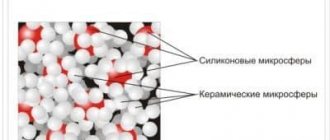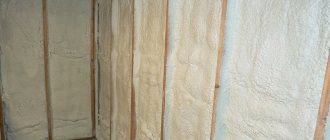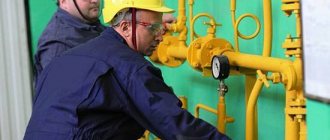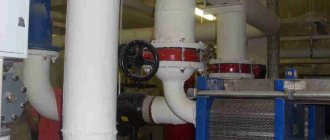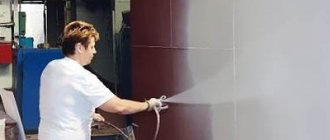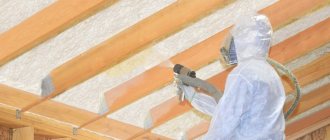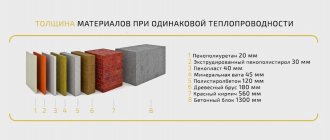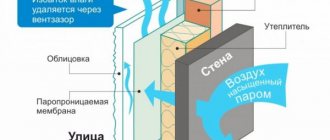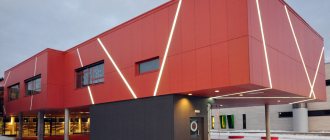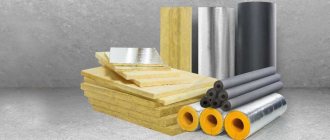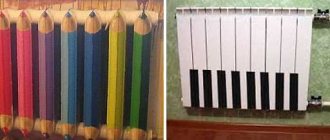Not long ago, many years of development by domestic manufacturers were crowned with success - the ceramic ultra-thin thermal insulation material Corundum Facade was released. Intended for concrete surfaces, this material is a facade paint that has vapor permeability and high thermal insulation properties.
The facade of a house finished with Corundum paint.
Numerous experiments and the availability of certificates of conformity allow the use of this material in various areas of construction:
- Energy complexes.
- Housing and communal construction (including for thermal insulation of roofs, for protection against corrosion of pipelines and gas pipelines).
- Individual construction.
Varieties of Corundum
Corundum series “Anticor” Today, domestic manufacturers produce the following varieties of Corundum:
- Corundum of the “Classic” series is an improved universal material for use on various surfaces (except facades) at temperatures from -60 0C to +260 0C.
- Corundum “Anticor” is an anti-corrosion, heat-protecting coating. It can be applied directly to the corrosion.
- Corundum “Facade” is a liquid-ceramic facade material with high vapor permeability properties.
- Corundum “Winter” can be used even in sub-zero temperatures. It is quite clear that the price of this material is not budgetary due to its special qualities.
Corundum for facade work
The main property of Corundum is increased thermal insulation
Builders call this material thin thermal insulation, since it can be applied in several layers of 1 mm or more at a time. Accordingly, the effort and time required to apply Corundum Facade to the surface is almost halved. Moreover, such work can be done with your own hands, without involving highly qualified specialists.
Need to know:
the use of this material increases the thermal insulation of the house significantly. Moreover, the homeowner significantly saves his own finances when purchasing this “two-in-one” material: the facade is simultaneously given a beautiful decorative appearance and its thermal insulation properties are increased.
Primer consumption rates for metal
When working with metal surfaces, it is advisable to additionally use a special primer, which will protect the material from rust formation in the future and generally improve its characteristics.
As a rule, each manufacturer indicates the primer consumption on the packaging. But such indicators are average, because there are many factors that can affect the amount of soil that will be required to treat a metal surface. Consumption can be increased even if it is necessary to apply several layers of the mixture. The first layer in most cases is almost completely absorbed by the base. The next layers will improve the characteristics of the metal and protect it from the effects of negative factors. Also, the consumption will be influenced by the specialist’s experience, the technique he uses during work and the method of applying the solution to the surface being treated.
When purchasing a primer, it is worth remembering that its main purpose is the anti-corrosion effect. Therefore, you should not buy primers that are made on the basis of acrylic, because they will not be able to further protect against the formation of rust on a metal surface. An excellent option would be GF-021 soil. In the case of this mixture, the average consumption will be 60-120 grams per square meter. More accurate indicators will depend on the quality of base preparation, as well as many other factors.
Effect of Corundum paint on the surface to be painted
Corundum Facade is a product for external and internal use. Many builders call this material “thermos paint”; this definition is predetermined by its properties:
- waterproofing;
- thermal insulation;
- noise canceling;
- protective (protects the outer walls of the building from changes in temperature and humidity, corrosion and mold).
Thus, as can be seen in the photo, Corundum paint can be used both as the main finishing material for the facade and as an auxiliary material.
Important to remember:
Corundum Facade is a water-based composite material, therefore it is an absolutely harmless and environmentally friendly product. These qualities of the material must be taken into account when decorating premises in children's, public and residential buildings.
The paint base is a polymer matrix, which consists of 80%:
- airless hollow microspheres;
- small silicone beads.
Heat-saving properties that Corundum Facade has After applying facade paint to the surface, the water evaporates and the paint polymerizes. That is, a waterproof elastic film is formed, the main purpose of which is to act as a “thermal barrier”. And, indeed, a polymer film consisting of evacuated microballs is capable of repelling and dissipating up to 85% of radiant energy and reducing the heat loss of a building significantly.
A few tips: how to apply Corundum paint on different types of surfaces
Corundum Facade can be applied to facades made of different building materials.
Finishing a concrete surface
Step-by-step instructions for applying Corundum to concrete surfaces:
- Preparatory stage:
- remove all unevenness and loose areas, dirt (including oily);
- remove milk from concrete;
- If necessary, level the surface with cement-plaster compounds.
- Prime the prepared surface with a special acrylic-based primer. Repeat application of primer at least 2 times when the previous layer is completely dry.
- Preparing Corundum for work:
- open the paint bucket;
- quickly stir the paint.
- Application of Corundum Facade paint to the surface:
- primer first layer.
A little advice:
It’s faster and easier to mix with a special attachment on an electric drill. But you need to remember that its rotation speed should not exceed 200 rpm.
Mixing Corundum
Advice:
use water as a thinner in a ratio of 20% of the total amount of paint;
- We wait for the material to dry completely.
Things to remember:
interlayer and final polymerization of the material occurs within 24 hours;
- applying the second and subsequent layers (if necessary), observing a 24-hour drying interval between layers. The consumption of corundum on the facade depends on the number of proposed layers.
A little advice:
There is no point in saving on this, as a layer that is too thin will not be able to provide high thermal conductivity.
Step-by-step application of Corundum paint on wooden facades
Painting a wooden facade
- Preparatory stage (watch video):
- manual or mechanical cleaning of old paint;
- sanding a wooden surface.
- Impregnation of wood with special antiseptics or water-based fire retardants.
- Preparing paint for work: quickly mix the paint in a bucket (it’s faster to do this using a special attachment on a drill).
- Layer-by-layer application of paint, subject to interlayer drying technology (at least 24 hours, in the warm season 12 hours is enough):
- For the first primer layer, prepare a more liquid composition.
A little advice:
add no more than 20% water;
- For all subsequent layers, prepare a more viscous composition.
A little advice:
add no more than 15% water.
As you can see, it is quite easy to apply Corundum Facade on your own if the instructions and our recommendations are followed correctly.
Ultra-thin thermal insulation Corundum. Highly economical innovation in construction and housing and communal services
Volgograd Innovation Resource Center has extensive experience in the development, production and implementation of innovative building materials, giving them the status of standard and traditional.
Today our range contains the following innovative products: ultra-thin thermal insulation Corundum. Today, Corundum has the following industrial modifications:
1 Corundum Classic
2 Corundum Anticorrosive
3 Corundum Winter
4 Corundum Facade
Request a free sample and see the performance we claim!
They are preparing for industrial production (laboratory samples are already available) of modifications.
The method and effectiveness by which the insulating material blocks heat redistribution, i.e. the process of temperature equilibrium, and determines the quality of insulation.
The content of microscopic ceramic spheres in the Corundum material is from 75% to 90%, depending on the modification.
Since the ceramic heat insulator Corundum on average consists of 80% microspheres, accordingly only 20% of the binder can conduct heat due to its thermal conductivity. The other share of heat comes from convection and radiation, and since the microsphere contains rarefied air (its thermal conductivity was written above), the heat loss is not large. Moreover, due to its structure, the material has low heat transfer from the surface, which plays a decisive role in its thermophysics.
Thus, it is necessary to separate two terms: Insulation and Heat Insulator, because In these materials, the physics of the heat transfer process is different:
The effectiveness of insulation directly depends on the thickness: the thicker the insulation layer, the better.
The thickness of the thermal insulation layer of the ultra-thin heat insulator KORUND varies from 1 to 6 mm, a subsequent increase has virtually no effect on its effectiveness.
The Russian market currently offers liquid ceramic heat-insulating materials that find their consumers due to their wide range of applications and ease of use with low labor costs. Since the materials offered are mainly produced abroad, they have a high cost, which limits the possibility of their mass use in construction, energy and housing and communal services, etc. While domestic analogues often leave much to be desired, both their “quality” and extremely high extra charge for cause negativity and bias among the end user towards liquid ceramic thermal insulation materials.
We are ready to answer all your questions. We have an unprecedented technical support option. We are forming a dealer network. We are ready to answer additional questions and discuss details.
Sincerely, Volgograd Innovation Resource Center Russia, 400131, Volgograd st. Komsomolskaya, 8 tel., 50-62-31 fax skype mirsvyazi ICQ 200784857
Source
How to choose Corundum thermal insulation
Liquid thermal insulation should be selected according to its intended purpose, namely where and for what purpose the material is planned to be used. Here are the following recommendations for use from the manufacturer of liquid thermal insulation: • for insulation of pipes under the foundation, it is recommended to use Corundum Classic, Facade and Anticorrosive, with a layer thickness of 1.5 mm. • to eliminate the phenomenon of condensation for cold water supply pipes, use Corundum Classic and Anticor with a layer thickness of 1-1.5 mm. • for coating pipes located indoors or outdoors, it is possible to use all modifications of Corundum with a layer thickness of up to 1.5 mm. • to create comfortable conditions in the presence of a “Cold Wall”, choose Corundum Facade with a coating of 1-1.5 mm. • Corundum Facade with a coating thickness of 2.5 to 3.5 mm will allow you to completely eliminate wall freezing. • Corundum Facade with a layer thickness of up to 1.5 mm will help with thermal insulation of the floor.
The consumption of corundum thermal insulation material depends on the modification. Rules and techniques for applying thermal insulation corundum are presented in the instructions for use from the manufacturer. Let us remind you that the thermal insulation can be applied using a paint brush, roller or paint sprayer for significant volumes and areas of thermal insulation. The basic rule when applying liquid heat insulator is that the thickness of the applied layer should be 0.3 mm and not thicker than 0.5 mm. The next layer is applied after the previous layer has completely dried.
The consumption rate when applying liquid insulator Corundum is: • when applying a layer with a paint brush (one layer) – 0.5 l/sq.m. • when applied by roller (one layer) – 0.4 l/sq.m • when using a sprayer – 0.26 l/sq.m.
Thermal insulation Corundum
Outdated and unpromising technologies of thermal insulation materials, limited to the use of traditional components, are currently replacing innovative technologies.
An example of this is the ultra-thin liquid thermal insulation Corundum. It is significant that the scope of liquid thermal insulation has expanded significantly due to its successful use for thermal insulation. Using liquid thermal insulation, it is possible to insulate external and internal surfaces: • water supply and air conditioning systems • building envelopes • building facades and internal walls • pipelines and air ducts • equipment chimneys • boiler steam pipelines.
What is the secret of such a wide geography of application of corundum thermal insulation?
Composition and properties of liquid thermal insulation
Let's start with the fact that liquid heat insulator has unique thermophysical properties that create plasticity and flexibility of the coating. The composition of the thermal insulation material is as follows: • high-quality acrylic binder • original texture of catalysts and fixatives • ceramic fillers of ultra-thin-walled microspheres.
Therefore, the unique thermal insulation properties are the result of the molecular action of rarefied air, which is located in the hollow spheres of the ceramic filler. In addition, special additives introduced into the composition of Corundum eliminate the formation of fungus and the appearance of corrosion in conditions of high humidity. Thermal insulation material in appearance resembles ordinary paint with a creamy consistency and is an opaque white suspension.
Regardless of the areas of application of liquid thermal insulation, corundum is a basic composition with stable adhesion to metal surfaces and building materials. Thermal insulation coating Corundum: • temperature-resistant (operating temperature from - 60°C to + 200°C) • vapor-tight • weather-resistant.
